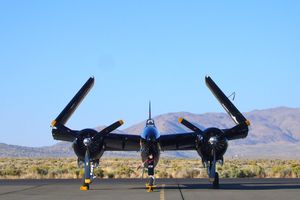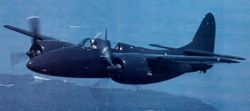PlaneSpottingWorld welcomes all new members! Please gives your ideas at the Terminal.
F7F Tigercat
| Grumman F7F Tigercat | |
|---|---|
| United States Navy F7F-3P in flight. | |
| Type | Fighter aircraft |
| Manufacturer | Grumman Aircraft Engineering Corporation |
| Maiden flight | 2 November 1943 |
| Introduced | 1944 |
| Retired | 1954 |
| Primary users | United States Navy United States Marine Corps |
| Produced | 1943-1946 |
| Number built | 364 |
The Grumman F7F Tigercat was the first twin-engined fighter aircraft design to enter service with the United States Navy. Designed for the new Midway class aircraft carriers, the aircraft were too large to operate from earlier decks. Although delivered to United States Marine Corps combat units before the end of World War II, the Tigercat did not see combat service in that war. Most F7Fs ended up in land-based service, as attack aircraft or night fighters; only the later F7F-4N was certified for carrier service. They saw service in the Korean war and were withdrawn from service in 1954.
Contents
Design and development
The contract for the prototype XF7F-1 was signed on June 30, 1941. Grumman's aim was to produce a plane that out-performed and out-gunned all existing fighter aircraft, and that had an auxiliary ground attack capability.[1] Armament was heavy: four 20 mm cannons and four 0.50 in (12.7 mm) machine guns, as well as underwing and under-fuselage hardpoints for bombs and torpedoes. Performance met expectations too; the F7F Tigercat was one of the highest-performance piston-engined fighters, with a top speed well in excess of the US Navy's single-engined aircraft - 71 mph faster than a F6F Hellcat at sea level.[2] The opinion of Capt. Fred M. Trapnell, one of the Navy's premier test pilots, was that the "It's the best damn fighter I've ever flown." [3]
All this was bought at the cost of heavy weight and a high landing speed, but what caused the aircraft to fail carrier suitability trials was poor directional stability with only one engine operational, as well as problems with the tail-hook design.[4] Therefore, the initial production series was only used from land bases by the USMC, as night fighters with APS-6 radar.[5] At first, they were single-seater F7F-1N aircraft, but after the 34th production aircraft, a second seat for a radar operator was added; these planes were designated F7F-2N.
The next version produced, the F7F-3 was modified to correct the issues that caused the aircraft to fail carrier acceptance and this version was again trialled on the USS Shangri-La. A wing failure on a heavy landing caused the failure of this carrier qualification too. F7F-3 aircraft were produced in day fighter, night fighter and photo-reconnaissance versions. [6]
A final version, the F7F-4N, was extensively rebuilt for additional strength and stability, and did pass carrier qualification, but only 12 were built. [7]
Operational use
Marine Corps night fighter squadron VMF(N)-513 flying F7F-3N Tigercats saw action in the early stages of the Korean War, flying night interdiction and fighter missions and shooting down two Polikarpov Po-2 biplanes.[8] This was the only combat use of the aircraft.
Most F7F-2Ns were modified to control drones for combat training, and these gained bubble canopies over the rear cockpit for the drone controller. A F7F-2D used for pilot tranisitoning also had a rear sliding, bubble canopy.[9]
In 1945, two Tigercats were evaluated, but rejected, by the British Royal Navy preferring a navalized version of the de Havilland Hornet. [10]
Survivors
A number of Tigercats were used as water bombers to fight forest fires in the 1960s and 1970s, and for this reason 12 examples exist today. Six of these are still airworthy.[11] [12]
As warbird racers, in 1976, Robert Forbes qualified an F7F-3N but did not race at Reno. Another modified F7F-3N Tigercat, (Bu No. 80503) "Big Bossman" owned by Mike Brown presently competes in the national air racing circuit.[[1]]
At least three F7F Tigercats are preserved in aviation musuems:
- F7F3 (Serial no. 80373/N7654C) National Museum of Naval Aviation, NAS Pensacola, Florida
- F7F3 (Serial no. 80410) Pima Air & Space Museum, Tucson, Arizona
- F7F-3P (Serial no. 80390/N700F) Kalamazoo Aviation History Museum, Kalamazoo, Michigan
Trivia
The Grumman F7F was originally named the "Tomcat" but this name was rejected as it was considered too suggestive.[13] The name would much later be used for the Grumman F-14.
Specifications (F7F-4N Tigercat)
Data from Jane's Fighting Aircraft of World War II[14]
General characteristics
- Crew: 2 (pilot, radar operator)
- Length: 45 ft 4 in (13.8 m)
- Wingspan: 51 ft 6 in (15.7 m)
- Height: 16 ft 7 in (5.1 m)
- Wing area: 455 ft² (42.3 m²)
- Empty weight: 16,270 lb (7,380 kg)
- Max takeoff weight: 25,720 lb (11,670 kg)
- Powerplant: 2× Pratt & Whitney R-2800-34W "Double Wasp" radial engines, 2,100 hp (1,600 kW) each
Performance
- Maximum speed: 400 knots (460 mph, 740 km/h)
- Range: 1,200 mi (1,000 nm, 1,900 km)
- Service ceiling: 40,400 ft (12,300 m)
Armament
- Guns:
- 4× 20 mm (0.787 in) M2 cannon
- 4× 0.50 in (12.7 mm) M2 Browning machine gun
- Bombs:
- 2× 1,000 lb (450 kg) bombs under wings or
- 1× torpedo under fuselage
Avionics
- AN/APS-19 radar
References
- ↑ Thruelsen 1976, p. 204.
- ↑ Meyer 2002, p. 51.
- ↑ Meyer 2002, p. 54.
- ↑ Meyer 2002, p. 55.
- ↑ Thruelsen 1976, p. 205.
- ↑ Taylor 1969, p. 504.
- ↑ Taylor 1969, p. 504.
- ↑ Grossnick and Armstrong 1997
- ↑ Gault 1973, p. 25.
- ↑ Zuk 2004, p. 129.
- ↑ Carr 1976
- ↑ O'Leary 2002
- ↑ Meyer 2002, p. 50.
- ↑ Jane, Fred T. “The Grumman Tigercat.” Jane’s Fighting Aircraft of World War II. London: Studio, 1946. p. 233. ISBN 1 85170 493 0.
- Carr, Orrin I. Fire 'Cat! "Air Classics, Vol. 12, No. 9, Sept. 1976." Canoga Park, CA: Challenge Publications. p. 38-47.
- Gault, Owen. Grumman's Tiger Twins: The Skyrocket & Tigercat. "Air Classics, Vol. 9, No. 8, Aug. 1973." Canoga Park, CA: Challenge Publications. p. 22-27.
- Green, William. Fighters Vol. Four (War Planes of the Second World War) New York: Doubleday and Company, Inc., 1961.
- Grossnick, Roy A. and Armstrong William J. United States Naval Aviation: 1910-1995. Annapolis: Naval Historical Center, 1997. ISBN 0-16049-124-X.
- Meyer, Corwin ("Corky") H. F7F Tigercat: The Untold Story. "Flight Journal, August 2002. Ridgefield, CT: AirAge Publications. p. 48-56, 58.
- O'Leary, Michael. Tigercat Restoration. "Air Classics, Vol. 38, No. 11, Nov. 2002." Canoga Park, CA: Challenge Publications.
- Taylor, John W. R. Grumman F7F Tigercat. "Combat Aircraft of the World from 1909 to the present." New York: G.P. Putnam's Sons, 1969. ISBN 0-425-03633-2.
- Thruelsen, Richard. The Grumman Story. New York: Praeger Publishers, Inc., 1976. ISBN 0-275-54260-2.
- Zuk, Bill. Janusz Zurakowski: Legends in the Sky. St. Catharine's, Ontario: Vanwell, 2004. ISBN 1-55125-083-7.
External links
F7F Tigercat "Big Bossman" air Racer
Related content
Designation sequence
Related lists
Lists relating to aviation | |
|---|---|
| General | Timeline of aviation · Aircraft · Aircraft manufacturers · Aircraft engines · Aircraft engine manufacturers · Airports · Airlines |
| Military | Air forces · Aircraft weapons · Missiles · Unmanned aerial vehicles (UAVs) · Experimental aircraft |
| Notable incidents and accidents | Military aviation · Airliners · General aviation · Famous aviation-related deaths |
| Records | Flight airspeed record · Flight distance record · Flight altitude record · Flight endurance record · Most produced aircraft |
de:Grumman F7F hr:Tigercat F7F it:Grumman F7F Tigercat ja:F7Fタイガーキャット (戦闘機) pl:Grumman F7F Tigercat



